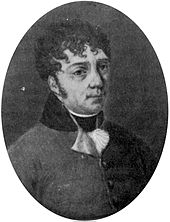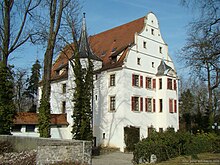Lehen Castle (Kochendorf)
The Schloss Lehen is a 1553-built Renaissance - castle in Bad Friedrich-Kochendorf in the district of Heilbronn in northern Baden-Württemberg . It is located in a small castle park on the banks of the Kocher , near the mouth of the Kocher in the Neckar . The castle is part of Burgenstrasse as a single structure . The complex, which goes back to an older moated castle , got its name from the fact that the property connected with it had been a fiefdom since 1294 .
history
Early history, gentlemen von Kochendorf
There was a Franconian manor house in the early Middle Ages where Lehen Castle is today. Later a moated castle was built in its place, which was outside the village wall. The moated castle was first mentioned in 1294, when Arnold von Kochendorf transferred the castle from his allodial property to a fiefdom, while at the same time he left various goods and rights in Kochendorf to the Wimpfen monastery , including the right of patronage for the parish church.
The lords of Kochendorf were servants of the German emperor or his ministerial, the lords of Weinsberg , but became impoverished and in the end only held lower offices. In 1450, with the death of the spiritual brother Johann von Kochendorf, the Lords of Kochendorf died out.
Fief of Messrs Greck von Kochendorf
The castle feud of the Lords of Kochendorf, which they last owned from the Lords of Heinriet, came to the Greck von Kochendorf in 1440 , which has been documented since the late 13th century and has been called von Kochendorf since 1315 . The first Greck in possession of the castle fief, which was awarded as an imperial fief after the lords of Heinriet died out in 1462, was probably Kraft Greck († around 1480).
After the moated castle was probably devastated by peasants in the Peasants' War in 1525 and Wolf Conrad Greck I had regained a share in Kochendorf that had briefly passed on to his stepsister through an inheritance division in 1549, he left the renaissance style castle on the site of the former moated castle in 1553 rebuild. The coat of arms stone above the castle entrance shows his coat of arms and that of his wife Sibylla Greck nee. von Gemmingen († 1567), daughter of the local lord of Gemmingen Wolf von Gemmingen . Under the coat of arms there is a saying from Psalm 127. The castle's dairy was built in 1568.
In 1606 Johann Philipp Greck sold his third of Kochendorf with the Lehen Castle to Friedrich I of Württemberg, who wanted to build a trading port in Kochendorf. The purchase negotiations were conducted by four Württemberg councilors, including Georg Eßlinger , who was born in Kochendorf . There were still further purchase negotiations for other parts of Kochendorf, but the port plans were shattered with the death of Frederick I in 1608. In the same year the reversal of the purchase, which was completed by 1615, began.
In a travel report from 1621/22, the castle (in contrast to the Greckenschloss , which has been built in the meantime ) is referred to as the Old Castle . About the forecourt of the castle, the fortifications of which are still largely preserved today, it is said that it is surrounded by a moat and reinforced by three towers.
The Greck von Kochendorf family held the castle feud for eight generations until the male line died out with the death of Wolf Conrad Greck V in 1749.
Fief of the barons of Gemmingen


The imperial fiefdom was withdrawn and awarded to Reinhard von Gemmingen-Hornberg (1677–1750), a member of the Hornberg tribe of the barons of Gemmingen . He was general director of the three knight circles united to form the imperial knighthood. His son of the same name, Reinhard von Gemmingen-Hornberg (1710–1775), initially shared the property with his brother Eberhard August (1717–1758) and after his early childless death became sole property . On the gable of the bay window on the south side of the building, he had a coat of arms stone (no longer legible today due to weathering) with his coat of arms and that of his wife Sophia Friederica vom Stein (1715–1776). The son Franz Karl Friedrich von Gemmingen-Hornberg (1747–1814) initially obtained a fiefdom and two thirds of the blood ban like his father, but in 1784 the emperor awarded the blood ban to the respective canton director of the knightly canton of Odenwald , which had resided in Kochendorf since 1762 , thereby taking possession of the property at Schloss Lehen only the lower jurisdiction was connected. Nevertheless, the jurisdiction remained in the family, since with Philipp von Gemmingen (1702–1785) and Karl Friedrich Reinhard von Gemmingen (1739–1822) the last two captains of the knightly canton of Odenwald from the one with the feudal bearers at Lehen Castle, only about one a dozen generations back common ancestors related tribe Gemmingen-Guttenberg came.
In the late 18th century, the castle fiefdom included not only the actual castle but also larger pieces of land. According to a report by the bailiff Schöpf from 1765, the property comprised around 77 acres of land, a contemporary profit book lists around 65 acres of land, around two thirds of which are fields, the rest are meadows, vineyards and gardens. From 1750 to 1766 the estate generated 9,329 guilders, mostly from fruit and wine. The expenditures and construction charges amounted to over 9,900 guilders in the same period, so that the property was not economically successful at all times.
Allodification and private ownership
With the end of the Holy Roman Empire in 1806, the overlordship passed from the Emperor to the Württemberg king, who after Franz Karl Friedrich's death in 1814 awarded the Württemberg general Johann Carl Georg Freiherr von Breuning (1785–1847). In 1818, Breuning had the curtain wall around the castle removed and the moat redrawn. Around 1825 he had to cede part of the palace garden to build the driveway for the new Kocher Bridge.
1854 the castle was a fief allodifiziert what 1863 Breuning's widow Sophie Valeska Baroness acquired from Beuting (1806-1890) the castle of her two sons as a widow seat. Breuning's youngest daughter Martha (1846–1874) married Heinrich Capler von Oedheim (1835–1914) in 1866 . After Martha's death, Heinrich entered into a second marriage with her sister Camilla (1837–1917) and in 1886 bought the castle from his mother-in-law. The small alliance coat of arms of Bautz / Breuning on the lower part of the southern bay dates from that time. After 1881 the third round tower of the forecourt was demolished in favor of another gate entrance. After the death of Heinrich Capler, the Kochendorfer castle came to his younger son Dietrich Capler von Oedheim called Bautz (1876-1967), who had to sell his Kochendorfer property in 1928 for economic reasons, whereby the castle came to the gardener Paul Mauk.
Use as a hotel
In 1948 the barn belonging to the dairy farm was redesigned. Garages were installed on the ground floor and apartments on the first floor. When the manufacturer Karl Erwin Merkle from Neckarsulm acquired Lehen Castle in 1953 , he had it converted into a hotel through renovation work; The complex has been used as a castle hotel to the present day. From 2001 to 2005 the listed building was extensively renovated.
Building description
Lehen Castle is a three-storey stone house in the Renaissance style. The front side is adorned with a curved gable, while the opposite stepped gable is more simply designed. On the side of the building there is an octagonal stair tower, which is crowned by a pointed roof. The ground floor of the castle is vaulted. The knight's hall is also located there . The ornate coat of arms stone above the main portal shows the alliance coat of arms of the Grecken and the Lords of Gemmingen , since Wolf Conrad Greck I was married to Sybilla von Gemmingen. The date 1553 probably indicates the completion of the new palace. Below is an inscription from Psalm 127.
To the south of the castle is the forecourt with the curtain wall and the former farm buildings. In front of the curtain wall there used to be a moat, which is now filled in, over which a bridge led. In front of the buildings in the forecourt are two massive round towers (originally there were three round towers). Between these towers a gate leads into the palace garden. Above it are the family coats of arms of the Grecken von Kochendorf and the Lords of Gemmingen; the year 1568 indicates the year of construction of the gate.
literature
- Karl Hugo Popp, Hans Riexinger : The Grecken von Kochendorf . In: Bad Friedrichshall 1933–1983 . City of Bad Friedrichshall, Bad Friedrichshall 1983
- Carl Wilhelm Friedrich Ludwig Stocker : Family Chronicle of the Barons of Gemmingen , Heidelberg 1895, p. 271ff.
Individual evidence
- ↑ Lothar Hantsch: Field names in the area of today's town markers Bad Friedrichshall in the 18th century . In: Historischer Verein Heilbronn, 24th publication , Heilbronn 1963
Web links
Coordinates: 49 ° 13 '32.5 " N , 9 ° 13' 1.9" E





